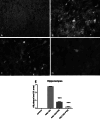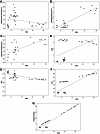Methanolic extract of Piper nigrum fruits improves memory impairment by decreasing brain oxidative stress in amyloid beta(1-42) rat model of Alzheimer's disease
- PMID: 24442916
- PMCID: PMC11488899
- DOI: 10.1007/s10571-014-0028-y
Methanolic extract of Piper nigrum fruits improves memory impairment by decreasing brain oxidative stress in amyloid beta(1-42) rat model of Alzheimer's disease
Abstract
The present study analyzed the possible memory-enhancing and antioxidant proprieties of the methanolic extract of Piper nigrum L. fruits (50 and 100 mg/kg, orally, for 21 days) in amyloid beta(1-42) rat model of Alzheimer's disease. The memory-enhancing effects of the plant extract were studied by means of in vivo (Y-maze and radial arm-maze tasks) approaches. Also, the antioxidant activity in the hippocampus was assessed using superoxide dismutase-, catalase-, glutathione peroxidase-specific activities and the total content of reduced glutathione, malondialdehyde, and protein carbonyl levels. The amyloid beta(1-42)-treated rats exhibited the following: decrease of spontaneous alternations percentage within Y-maze task and increase of working memory and reference memory errors within radial arm-maze task. Administration of the plant extract significantly improved memory performance and exhibited antioxidant potential. Our results suggest that the plant extract ameliorates amyloid beta(1-42)-induced spatial memory impairment by attenuation of the oxidative stress in the rat hippocampus.
Conflict of interest statement
The authors declare that they have no conflict of interest.
Figures






References
-
- Ausubel FM, Brent R, Kingston RE, Moore DD, Seidman JG, Smith JA, Struhl K (2002) Current protocol in molecular biology. Wiley-Interscience, Hoboken
-
- Bagheri M, Joghataei M-T, Mohseni S, Roghani M (2011) Genistein ameliorates learning and memory deficits in amyloid β(1–40) rat model of Alzheimer’s disease. Neurobiol Learn Mem 95(3):270–276. doi:10.1016/j.nlm.2010.12.001 - PubMed
-
- Behl C, Davis J, Lesley R, Schubert D (1994) Hydrogen peroxide mediates amyloid beta protein toxicity. Cell 77:817–827 - PubMed
-
- Butterfield D, Lauderback C (2002) Lipid peroxidation and protein oxidation in Alzheimer’s disease brain: potential causes and consequences involving amyloid β-peptide associated free radical oxidative stress. Free Radic Biol Med 32:1050–1060 - PubMed
-
- Cetin F, Dincer S (2007) The effect of intrahippocampal beta amyloid (1–42) peptide injection on oxidant and antioxidant status in rat brain. Ann N Y Acad Sci 1100(1):510–517. doi:10.1196/annals.1395.056 - PubMed
Publication types
MeSH terms
Substances
LinkOut - more resources
Full Text Sources
Other Literature Sources
Medical

